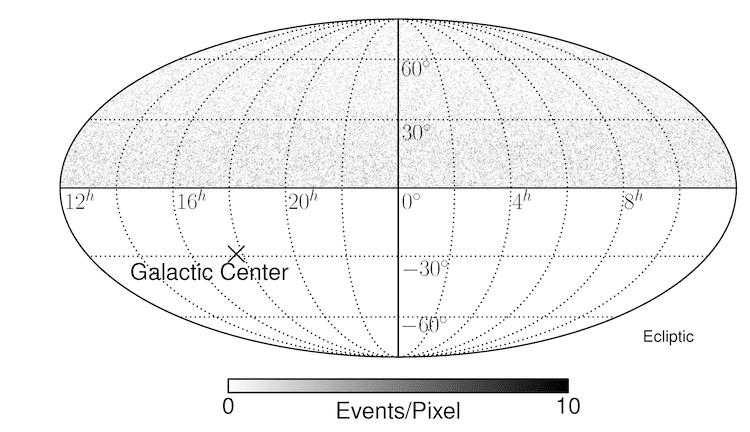Dark matter is supposedly everywhere in our Universe, accounting for many of its properties, such as the rotational velocity of galaxies or even the pattern of anisotropies in the cosmic microwave background. In our galaxy, the Milky Way, dark matter might constitute up to 95% of all matter, with its borders extending far beyond the visible disk. This is the so-called dark matter halo.
The quest for galactic halo dark matter includes high-energy neutrino searches that might be produced by the self-annihilation of dark matter particles in our galaxy. If this is the case, IceCube should observe a characteristic anisotropy in the neutrino flux due to the additional dark-matter induced neutrinos. So far, the IceCube Collaboration has not found any significant deviation from the background expectation, following new results that have been submitted today to The European Physical Journal C.


On the left, sky map of reconstructed neutrino arrival direction of the experimental data sample in equatorial coordinates. On the right, the dimensionless line-of-sight integral for the NFW profile is shown for the Northern Hemisphere in equatorial coordinates. The anisotropy in the line-of-sight integral causes the anisotropy in the expected flux of neutrinos from self-annihilation of dark matter in the Galactic halo. In both figures, the position of the Galactic Center is indicated by the cross. Images: Icecube Collaboration
Upgoing muon events were selected from data taken by the IceCube detector between June 2010 and May 2011. This selection eliminates most of the background events, since cosmic-ray induced muons will be absorbed by the Earth. The expected dark-matter neutrino flux is calculated using the Navarro, Frenk and White (NFW) model as a baseline, and the model dependence, estimated from the Burkett model, has been found to be small. The main uncertainties are associated with the optical efficiency of the IceCube sensors and the optical properties of the Antarctic ice (estimated to be in the 15-30% range).
“The paper presents a new technique, using a multipole expansion of the neutrino arrival direction sky map, that is an ideal way to search for anisotropies in the sky. It is a very flexible and robust method. Furthermore, it provides an easy way to reduce special systematic uncertainties,” explains René Reimann, an IceCube researcher at RWTH Aachen.
As no signal was observed, IceCube researchers set up exclusion limits on the self-annihilation cross-section, which improve the ones obtained in a previous analysis and are competitive with the ones obtained from gamma experiments. These limits are set for a generic candidate for dark matter, a weakly interacting massive particle (WIMP), with a mass range from a hundred GeV to 105 GeV.
Info “Multipole analysis of IceCube data to search for dark matter accumulated in the Galactic halo,” IceCube Collaboration: M.G. Aartsen et al. The European Physical Journal C75 (2015) 99, arXiv.org:1406.6868 link.springer.com